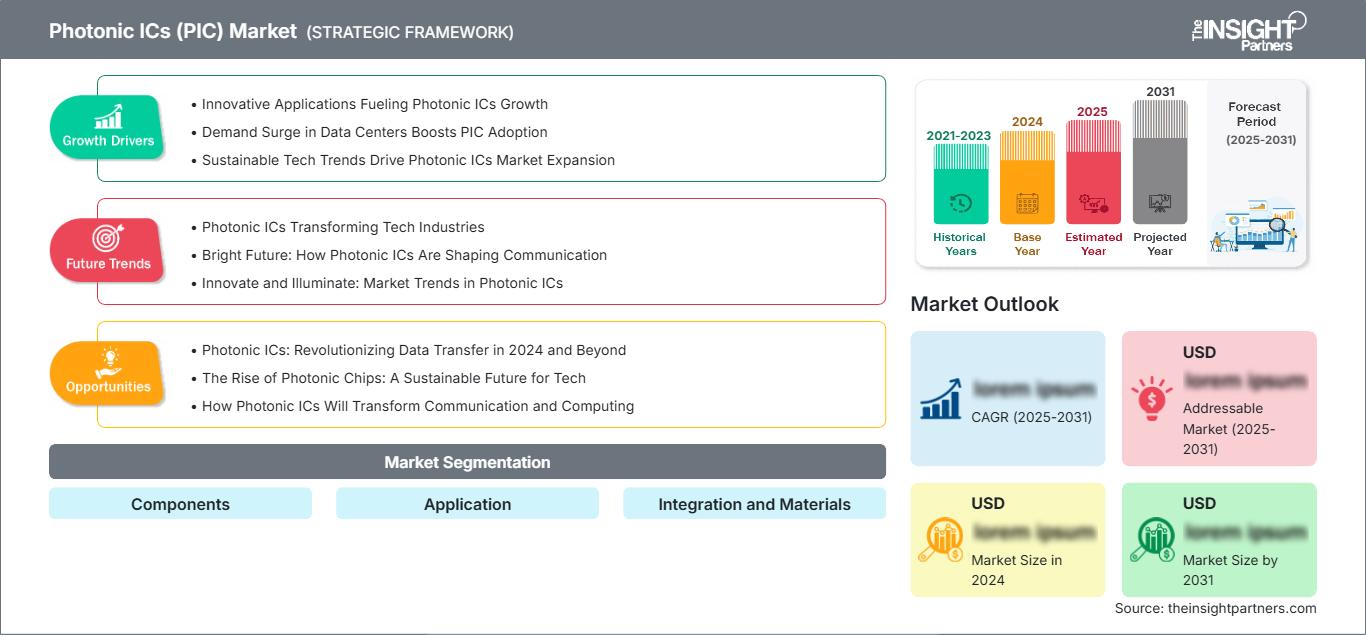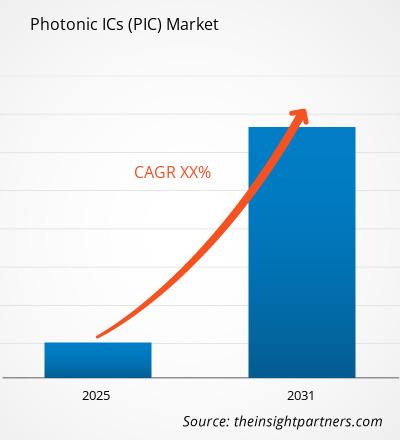I circuiti integrati fotonici (PIC), con funzioni analoghe ai circuiti integrati elettronici, utilizzano fotoni anziché elettroni per trasportare dati. I fotoni, unità di misura della luce, viaggiano a una velocità comparativamente molto più elevata rispetto ad altri supporti dati, quindi la velocità di trasferimento dati è aumentata drasticamente. Si prevede che il mercato globale dei circuiti integrati fotonici crescerà a un ritmo notevole, offrendo miglioramenti sostanziali in termini di dimensioni del sistema, consumo energetico, costi e affidabilità. In base all'applicazione, il mercato globale dei circuiti integrati fotonici è segmentato in biofotonica, comunicazione ottica, sensori, elaborazione del segnale ottico e nanofotonica. Il mercato globale dei circuiti integrati fotonici è ulteriormente segmentato in base ai metodi di integrazione impiegati in integrazione monolitica, integrazione ibrida e integrazione modulare. Inoltre, il mercato globale dei circuiti integrati fotonici è segmentato in base ai componenti, ovvero: modulatori, laser, multiplexer/demultiplexer, rilevatori, amplificatori ottici e altri (come attenuatori, convertitori di lunghezza d'onda, ecc.). Il mercato è segmentato in base ai materiali, ovvero: niobato di litio (LiNbO3), fosfuro di indio (InP), silicio (Si), arseniuro di gallio (GaAs) e silice su silicio. La continua limitazione dei circuiti integrati elettronici, dovuta alla necessità di aggiungere più transistor su un singolo substrato di silicio, ha spinto l'industria a inventare un sostituto. Inoltre, i principali attori del mercato hanno sviluppato circuiti integrati fotonici basati su InP combinati monoliticamente, che integrano oltre 600 componenti/utilità in un singolo chip. Di conseguenza, sul mercato si registra un'enorme concorrenza, poiché ogni singolo attore punta a inventare prodotti basati su circuiti integrati fotonici in grado di integrare grandi quantità di funzioni/utilità a basso costo. Il risparmio di budget e di entità, ottenuto integrando diversi moduli ottici, inclusi modulatori, rilevatori e laser, in un unico package, è l'obiettivo principale per gli attori del mercato dei circuiti integrati fotonici. La crescente domanda di comunicazioni ad alta velocità, unita allo sviluppo di aree applicative, in particolare nei settori della sensoristica, delle comunicazioni ottiche e della biofotonica, ha alimentato il progresso del mercato globale dei circuiti integrati fotonici. Inoltre, l'elevata efficienza energetica, la fabbricazione economica, la maggiore affidabilità e le elevate velocità di trasferimento dati offerte dai circuiti integrati fotonici sono fattori che dovrebbero dare impulso a questo mercato. L'uso dei fotoni per offrire elaborazione, calcolo e trasmissione dati ad alta velocità offre una solida prospettiva per lo sviluppo del mercato dei circuiti integrati fotonici. L'applicazione dei sensori ottici è un'applicazione emergente in questo mercato, utilizzata in settori come l'aerospaziale, la difesa, i trasporti, l'energia e la medicina. Il calcolo quantistico, una tecnologia di prossima commercializzazione, è un altro segmento che promette un utilizzo significativo dei circuiti integrati fotonici. I circuiti integrati fotonici sono utilizzati anche in ambito biomedico, dove l'uso consolidato di circuiti integrati fotonici specifici basati su InP viene utilizzato per l'esame diagnostico dei tessuti cutanei opachi. Le comunicazioni ottiche rappresentano un settore applicativo leader nel mercato dei circuiti integrati fotonici, mentre la biofotonica e la sensoristica sono gli altri segmenti applicativi chiave. Sebbene l'attuale contributo del segmento dell'elaborazione del segnale ottico sia minimo, si prevede che registrerà un forte progresso dopo la commercializzazione del calcolo quantistico. Il Nord America è leader nel mercato globale dei circuiti integrati fotonici, seguito da Europa e Asia-Pacifico. Sebbene il Nord America sia il principale mercato dei circuiti integrati fotonici, si prevede che l'Asia-Pacifico registrerà una forte crescita, superando l'Europa e, in ultima analisi, il Nord America. Lo sviluppo nell'Asia-Pacifico può essere attribuito in gran parte alla crescente domanda di applicazioni di comunicazioni ottiche e biofotonica. Il mercato mondiale dei circuiti integrati fotonici è estremamente frammentato e caratterizzato dalla presenza di un gran numero di attori. Tra i principali attori del mercato figurano Alcatel-Lucent SA, Infinera Corporation, JDS Uniphase Corporation, Huawei Technologies Co. Ltd., Avago Technologies Ltd., Intel Corporation, Agilent Technologies, Ciena Corporation, Emcore Corporation e NeoPhotonics Corporation.
Potrai personalizzare gratuitamente qualsiasi rapporto, comprese parti di questo rapporto, o analisi a livello di paese, pacchetto dati Excel, oltre a usufruire di grandi offerte e sconti per start-up e università
Mercato dei circuiti integrati fotonici (PIC): Approfondimenti strategici

-
Ottieni le principali tendenze chiave del mercato di questo rapporto.Questo campione GRATUITO includerà l'analisi dei dati, che vanno dalle tendenze di mercato alle stime e alle previsioni.
Approfondimenti regionali sul mercato dei circuiti integrati fotonici (PIC)
Le tendenze regionali e i fattori che influenzano il mercato dei circuiti integrati fotonici (PIC) durante il periodo di previsione sono stati ampiamente spiegati dagli analisti di The Insight Partners. Questa sezione illustra anche i segmenti e la geografia del mercato dei circuiti integrati fotonici (PIC) in Nord America, Europa, Asia-Pacifico, Medio Oriente e Africa, America meridionale e centrale.
Ambito del rapporto di mercato sui circuiti integrati fotonici (PIC)
| Attributo del rapporto | Dettagli |
|---|---|
| Dimensioni del mercato in 2024 | US$ XX million |
| Dimensioni del mercato per 2031 | US$ XX Million |
| CAGR globale (2025 - 2031) | XX% |
| Dati storici | 2021-2023 |
| Periodo di previsione | 2025-2031 |
| Segmenti coperti | By ComponentiBy ApplicazioneBy Integrazione e Materiali |
| Regioni e paesi coperti |
Nord America
|
| Leader di mercato e profili aziendali chiave |
|
Densità degli operatori del mercato dei circuiti integrati fotonici (PIC): comprendere il suo impatto sulle dinamiche aziendali
Il mercato dei circuiti integrati fotonici (PIC) è in rapida crescita, trainato dalla crescente domanda degli utenti finali, dovuta a fattori quali l'evoluzione delle preferenze dei consumatori, i progressi tecnologici e una maggiore consapevolezza dei vantaggi del prodotto. Con l'aumento della domanda, le aziende stanno ampliando la propria offerta, innovando per soddisfare le esigenze dei consumatori e sfruttando le tendenze emergenti, alimentando ulteriormente la crescita del mercato.

- Ottieni il Mercato dei circuiti integrati fotonici (PIC) Panoramica dei principali attori chiave
- Analisi storica (2 anni), anno base, previsione (7 anni) con CAGR
- Analisi PEST e SWOT
- Valore/volume delle dimensioni del mercato - Globale, Regionale, Nazionale
- Industria e panorama competitivo
- Set di dati Excel
Report recenti
Testimonianze
Motivo dell'acquisto
- Processo decisionale informato
- Comprensione delle dinamiche di mercato
- Analisi competitiva
- Analisi dei clienti
- Previsioni di mercato
- Mitigazione del rischio
- Pianificazione strategica
- Giustificazione degli investimenti
- Identificazione dei mercati emergenti
- Miglioramento delle strategie di marketing
- Aumento dell'efficienza operativa
- Allineamento alle tendenze normative






















 Ottieni un campione gratuito per - Mercato dei circuiti integrati fotonici (PIC)
Ottieni un campione gratuito per - Mercato dei circuiti integrati fotonici (PIC)